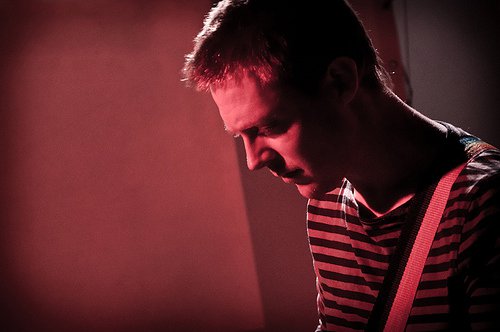Comments
Visionary Hours – blind collaborations
Visionary Hours talks about how he asked friends and Preserved Sound artists to contribute their own unique sound to his new album Beyond the White, and why the album is influenced by the pantheism of 8th century Chinese poet Wang Wei.
How did you approach writing Beyond the White?Visionary Hours: I deliberately set out to write a collection of instrumental finger-picked guitar pieces, with the idea to ask friends and Preserved Sound artists, past and present, to record overdubs onto the pieces, interpreting the piece and adding to them in their own way.
The pieces were recorded as complete, live takes on my old Framus archtop guitar on a winter night in Krakow, and you can sometimes hear the clicking of the radiator in the room as it heats up and cools down.
Is this the concept of the album?
Yes, absolutely. I wanted to collaborate with different artists, but still keep some kind of control over the pieces. So where two artists would perhaps sit together in a room and write a piece together, I already had the finished piece that obviously influenced the kind of overdubs they would record.
I spent quite a while deciding which artist I thought would respond the best to which piece – and tried to match the right artist to the right piece. I didn’t have any restrictions in terms of how the artists should add overdubs, and encouraged them to record as many different tracks and instruments as they wanted to. The only condition I stated was that I would have the right to edit the overdubbed tracks and that I could decide which overdubbed tracks to use and which not to use.
In some cases, I sent the same acoustic guitar piece out to more than one artist, with the idea that two artists would unwittingly collaborate with each other on that particular piece – a kind of blind collaboration.
So Richard Youngs collaborates with Western Skies Motel on “away into endless spaces”, and Isnaj Dui collaborates with Adrian Lane on “evening mists have no resting place”. Other artists that contribute to the album are Bruno Sanfilippo, Trigg & Gusset, 3+, Unconditional Arms, The Sly and the Unseen, Alex Lipinski and Adrianna Maria Kafel.
What defines the sound of Beyond the White?
The sound of my beaten up Framus archtop and the room it was recorded in, as well as Revox B77 tape echo certainly have a major impact on the sound, but the pieces are also characterised by the individual artists that played on them.
For example, I sent “where the wind sharpens the goodbye” to Trigg & Gusset, I was amazed when they sent back the overdubs. Bart had recorded an amazing sequence of chords on Fender Rhodes that roots the composition in a completely different way and really changes the whole feel of the piece. And Eric’s saxophone floats on the top and interacts with my own clarinet parts in a way I would never have written myself.
You use a lot of tape echo on the album. Could you explain how you achieved this?
This is perhaps the most important contribution to the album and you can hear tape echo on pretty much every track. Like my last album, Footfalls Echo, I knew that I wanted to use tape echo on the album, but didn’t have the hardware to create it. So I made some test mixes using tape echo plugins as a kind of reference point and sent them to Richard Formby, with mixing notes outlining what I wanted to achieve on the final mixes.

The sound is often dirty, patchy and distorted, and the feedback isn’t as easily controlled as it is with plugins. And it’s this that creates the depth of sound. Even used in a subtle way, real tape echo adds a quality that can’t be achieved with plugins.
To me, the art of using tape echo in a creative way is a skill as much as playing an instrument is, and Richard is credited as playing tape echo on the album.
Could you talk about the significance of the titles of the pieces?
The titles on Beyond the White are lines taken from poems by 8th century Chinese poet Wang Wei. My music is very much influenced by the spirituality and mysticism that I get from the natural world, and the imagery in the poems really fit with how the pieces were taking shape as I was writing them.
In particular, I was very drawn to Wang Wei’s concept of “white clouds” and what they represent.
Finally, what’s next for Visionary Hours?
Anyone who writes music knows that it’s extremely addictive, and it’s something I can’t not do. My only challenge is finding enough time to dedicate to the writing and recording process.
But I have a few new album projects on the horizon. I have another artist collaboration album concept and a new project in which I use my voice more. So there’s much more to come!
